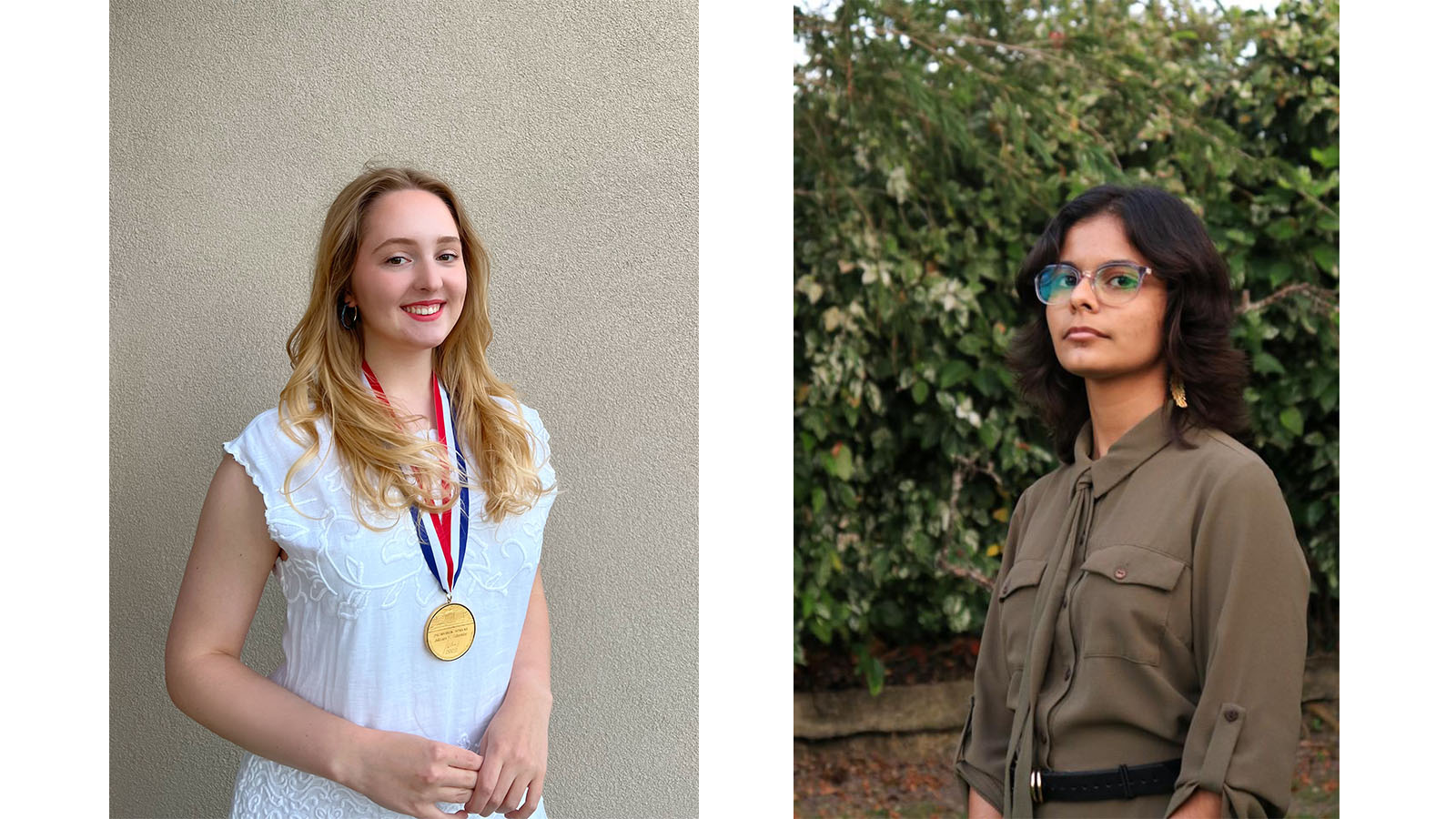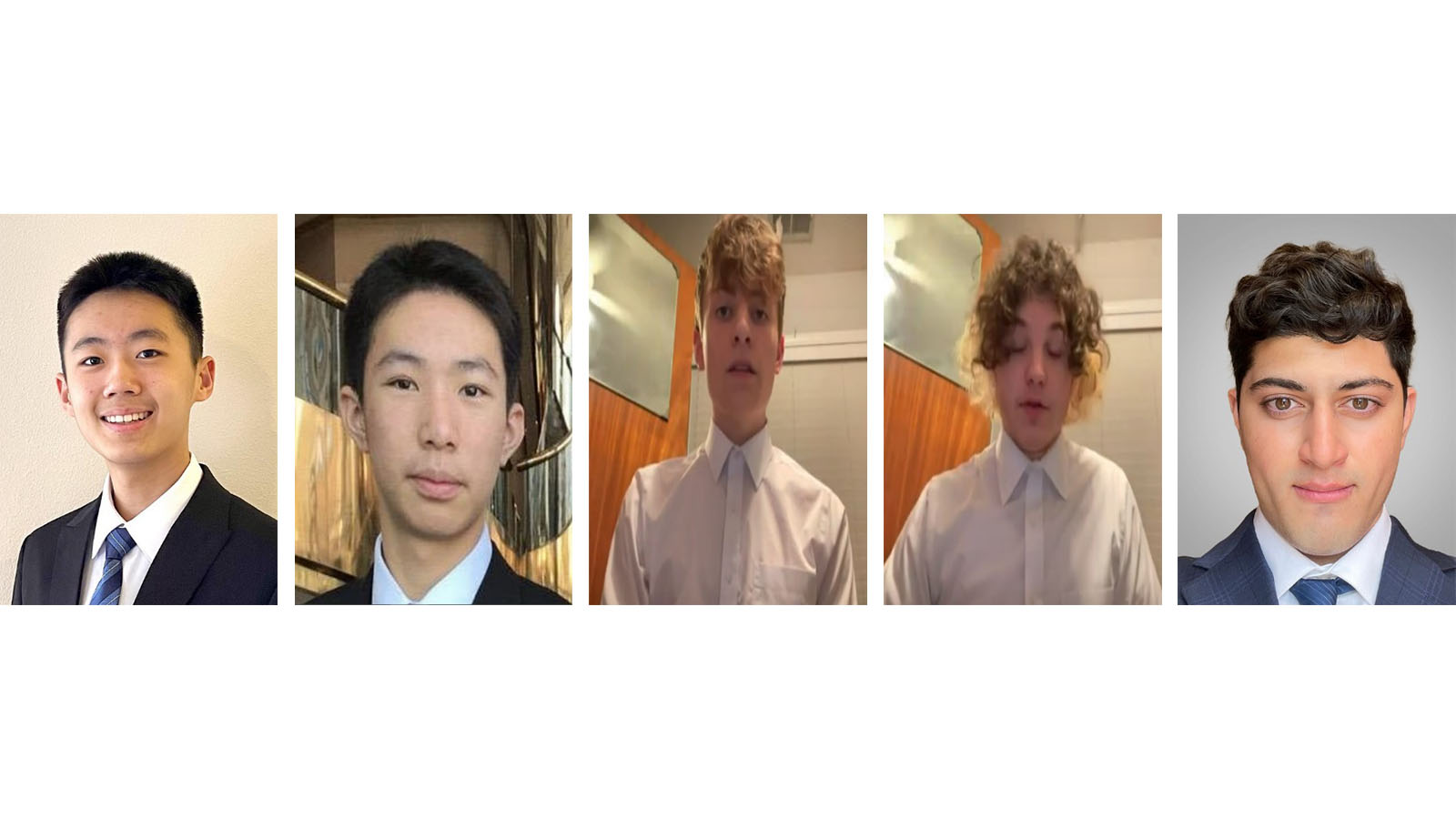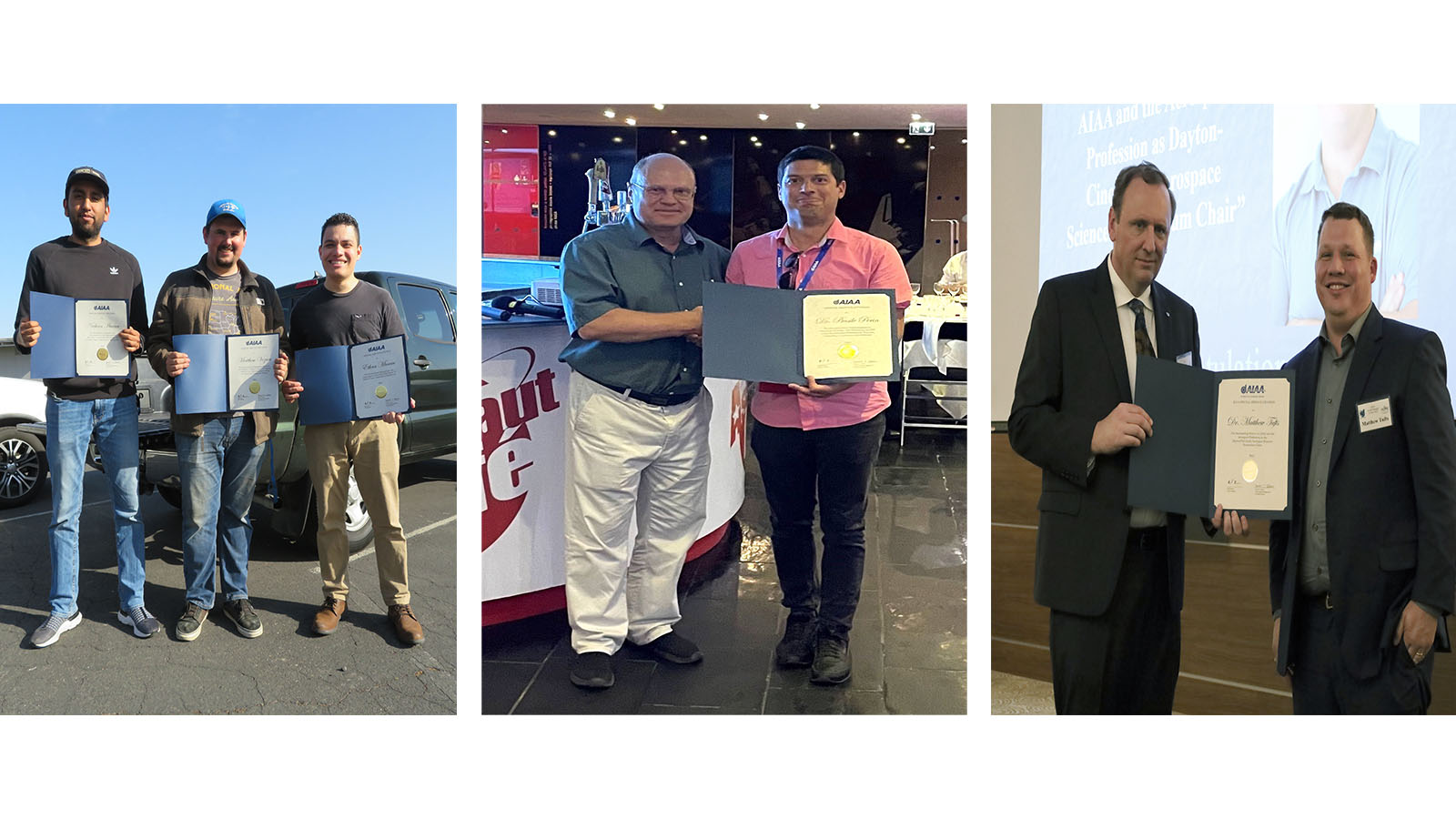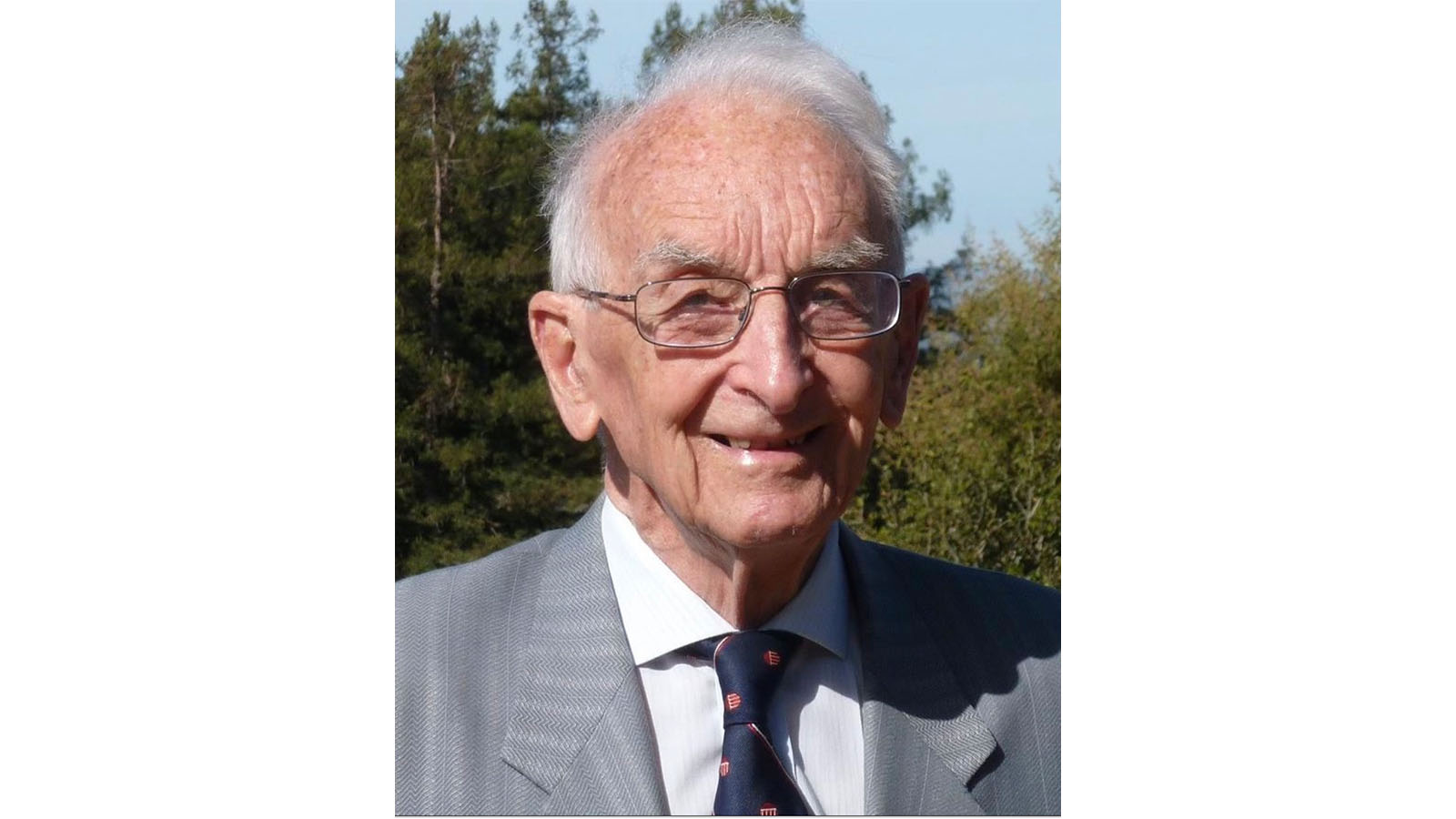Stay Up to Date
Submit your email address to receive the latest industry and Aerospace America news.

Making an Impact: AIAA Announces First Recipients of AIAA Lockheed Martin Marillyn Hewson Scholarship
AIAA announces the first recipients of the new AIAA Lockheed Martin Marillyn Hewson Scholarship. The two $10,000 scholarships have been awarded to:
High School Winner: Julianna Schneider, Admitted to the Massachusetts Institute of Technology. Julianna is a U.S. Presidential Scholar, National Merit Scholar, Congressional App Challenge Winner, and FTC Dean’s List Finalist. She led three FIRST robotics teams to win state, regional, and international awards and a team of NASA interns to publish research with the American Geophysical Union. Julianna created VoluntYOU, an award-winning, 501(c)(3)-backed digital platform that connects 500+ users to volunteering opportunities globally. She mentors with NASA summer programs, Science Olympiad, and FIRST robotics programs. She conducts research on improving human-robot collaboration using a pipeline of machine learning models. Julianna is an incoming freshman at MIT and will major in AI & Decision Making. She aspires to earn a graduate degree and develop novel AI architectures that improve autonomous navigation systems throughout her career as an AI engineer.
University Winner: Penélope Nieves-Colon, University of Puerto Rico, Mayaguez Campus. Penélope Nieves-Colon is a rising junior majoring in Mechanical Engineering at the University of Puerto Rico, Mayaguez Campus. Her plan is to continue studying after graduating with her bachelor’s degree to obtain a Ph.D. in Aerospace Engineering with a minor in Astronautics. Having an immense interest in outer space from an early age, she plans to pursue a career in the aerospace industry, working with the development of rocketry technologies and space travel.
The AIAA Lockheed Martin Marillyn Hewson Scholarship was created in 2022 to encourage young women to study aerospace engineering and pursue a career in the aerospace defense industry. The scholarship is named for Marillyn Hewson, former chairman, president, and chief executive officer of Lockheed Martin Corporation. She joined Lockheed Martin in 1983 as an industrial engineer. During her career she held leadership positions across the corporation, including president and chief operating officer; executive vice president of Lockheed Martin’s Electronic Systems business area; president of Lockheed Martin Systems Integration; executive vice president of Global Sustainment for Lockheed Martin Aeronautics.
Basil Hassan, chair of the AIAA Foundation, stated, “The AIAA Foundation is thrilled to help identify, mentor, and promote promising young aerospace talent through the AIAA Lockheed Martin Marillyn Hewson Scholarship. This new award is the first needs-based scholarship AIAA has offered, as a powerful investment in the journey of students from classroom to career. We recognize the generosity of our members and partners who help AIAA inspire as many students and educators as we can reach.”
Applications for the 2023 AIAA Lockheed Martin Marillyn Hewson Scholarship will open 1 October. AIAA again will award up to two $10,000 scholarships to one high school senior female and one undergraduate female with financial need who enroll in an accredited college or university and intend to pursue an aerospace or STEM major. Applicants must demonstrate interest in a career in the aerospace defense sector. Students from groups currently underrepresented in the aerospace profession are especially encouraged to apply. For more information, email [email protected].

AIAA “Look Up!” Award at Regeneron ISEF
From 8 to 13 May, 1,750 young scientists, engineers, entrepreneurs, and inventors convened both in person and virtually for a week of connecting with their peers and global STEM leaders, events, and $8 million in awards, prizes, and scholarships. It was the first time since 2019 that Regeneron International Science and Engineering Fair (ISEF) finalists had the opportunity to gather in person, and a hybrid format was offered as well. Presented at ISEF, the AIAA “Look Up!” Award celebrates exceptional high school-level research to encourage further study in aerospace.
Winners of the AIAA “Look Up!” Award receive a cash award and AIAA student membership with access to all student programs and upcoming partnership competitions and challenges. We congratulate the 2022 winners and encourage students to Look Up! and see their future in aerospace.
First Place ($2,000)
Kevin Shen, Freshman, Olympia High School, Olympia, WA (Virtual)
ETSD045—“A Novel Approach to Biomimicking the Avian Tail on Fixed Wing Micro Air Vehicles” (https://projectboard.world/isef/project/85289)
Second Place ($1,500)
Jue Wang, Junior, Milton Academy, Milton, MA (Virtual)
ETSD049—”Design and Fabrication of a Flapping-Wing Robot Based on Slider-Crank Mechanism” (https://projectboard.world/isef/project/85869)
Third Place ($1,000)
Joey Gorman, Senior, and Jonathan Gutknecht, Senior, Gwinnett School of Mathematics, Science, and Technology, Lawrenceville, GA (In person)
ETSD012T—”Small Satellite and Launch Vehicle for Climate Change Research” (https://projectboard.world/isef/project/82750)
Fourth Place ($500)
Ravin Joshi, Senior, Academies of Loudoun, Leesburg, VA (In person)
ETSD033—”Constructing a Reusable Solid-Fuel Rocket Capable of Propulsive Landing”(https://projectboard.world/isef/project/85280)
Honorable Mention
Guan-Yu Chen and Yu-Sheng Wang, Taipei Municipal Jianguo High School, Taipei City, Taiwan (Virtual)
ETSD035T — Performance Enhancement of PMMA/GOx Hybrid Rocket Engine Using Swirling Injection

AIAA Helps Students Reach for the Sky at the Conrad Challenge
The Conrad Challenge is an annual, multi-phase innovation and entrepreneurship competition that encourages young adults to participate in designing the future. Each year, teams of 2–5 students, ages 13–18, from around the world create products and/or services to address some of the most pressing global and local challenges. They become entrepreneurial problem-solvers, addressing challenging social, scientific, and societal issues through utilizing their creativity and critical-thinking skills. This year the 2022 Innovation Summit took place 26–29 April at Space Center Houston and NASA Johnson Space Center and featured 50 student teams from around the world who competed for the top honor: the Pete Conrad Scholar award.
Team AstraCell, from Lambert High School, Suwanee, GA, won the Aerospace & Aviation Pete Conrad Scholar award for their presentation of an innovative alternation fuel cell technology that alleviates traditional fuels safety and durability concerns, while optimizing cost and efficiency. The CEO of Team AstraCell, Varnica Basavaraj, was awarded the $2,500 AIAA Scholarship Award. Varnica stated, “Sustainability has always been an area of interest for me, and I hope to take my research from AstraCell which focused on greener fuel potential along with the generous grant from the AIAA and put it toward developing this pursuit.”
Calling All Educators: Apply for the AIAA Foundation Classroom Grant
The AIAA Foundation believes that educating and inspiring the next generation of aerospace professionals is one of the most important investments we can make. The classroom grant program aims to bridge the gap in STEM funding by awarding over 80 AIAA Educator Associate members with up to $500 for STEAM projects with an emphasis on aerospace.
The application is easy to complete: explain the project, itemize the list of materials needed, and submit! Learn more about grant rules and the application.
Application closes 30 September 2022. Sponsored by The Boeing Company.

SAT OC – Impactful Effects
By Amir S. Gohardani, SAT OC Chair
The AIAA Society and Aerospace Technology Outreach Committee (SAT OC) recently reconfirmed its mission to promote the transfer and use of aerospace technology for the benefit of society. A variety of topics with impactful effects made it to the discussion plane, including astrosociology.
Astrosociology is a multidisciplinary academic field that includes the social/behavioral sciences (e.g., sociology, anthropology, psychology, political science, economics, archeology), humanities, and arts. Astrosociology unites non-STEM fields with space-related issues so scientists can better collaborate. This is a similar approach to that of astrobiology. Jim Pass, lead contact for astrosociology at SAT OC, has shaped astrosociology for many years. Interested parties are encouraged to contact SAT OC if they are interested in this multidisciplinary academic field.
SAT OC Spotlight
In this issue, the SAT OC highlights Chi Mai, a member of the AIAA SAT OC since 2009. Chi is a senior aerospace engineer at the U.S. Government Accountability Office (GAO) on its Science, Technology Assessment, and Analytics team. He leads project teams to analyze recent science and technology developments, highlight potential effects of technological change, and make science and technology concepts readily accessible to policymakers and the public. Chi’s recent work involves satellite constellations and positioning, navigation, and timing alternatives to the GPS. He also supports GAO’s work in advanced air mobility, sustainable aviation fuels, hypersonic weapons, and defense capabilities.
At GAO Chi looks at emerging technologies and how they influence and are affected by social, legal, economic, and national security factors. This aligns with SAT OC’s focus areas of: 1) how aerospace technology and techniques help solve critical societal challenges and improve quality of life and 2) the interactions of the aerospace enterprise with broader social and cultural trends.
Prior to GAO, Chi was a research aerospace engineer for the Air Force Research Laboratory’s Munitions Directorate at Eglin Air Force Base. He conducted and supported wind-tunnel tests for commercial and government missile technology development programs. He also directed a series of small-scale experiments and managed a research portfolio for air blast. Chi received degrees in aerospace engineering from Texas A&M University. For his graduate studies, he received the Department of Defense Science, Mathematics, and Research for Transformation (DOD SMART) scholarship.
Chi serves on the advisory council for the AIAA North Texas Section. He also served as an officer for the AIAA Northwest Florida Section for several years, including as section chair (2017–2019), when the section was awarded Outstanding Section for 2018-2019 in the small section category. Chi also serves as an industry advisory board member for the Department of Aerospace Engineering at Embry-Riddle Aeronautical University–Daytona Beach. SAT OC takes pride in the success of its membership and celebrates individuals such as Chi for their skillsets, dedication, motivation, and drive to create a brighter future in a better society.
Diversity Corner
Name: Dr. Yanping Guo
Notable Contributions: Dr. Guo is a space mission designer and member of the Principal Professional Staff of the Johns Hopkins University Applied Physics Laboratory (APL). Dr. Guo has a long list of interplanetary mission design accomplishments as a developer and leader for several NASA mission proposals, studies, and flight projects. She has received numerous awards from many professional organizations, including the NASA Silver Achievement Medal. In 2004, the International Astronomical Union approved the name “Guo” for asteroid 28513 to celebrate her many contributions to the space and mission design field. She is an inspiration to the aerospace community and during AAPI Heritage she was recognized by AIAA for her achievements.
Potential Societal Impact of Contributions: Dr. Guo was highly influential in turning the much-studied but never realized Solar Probe into a doable mission, Parker Solar Probe. Using Venus instead of Jupiter for gravity assists, she enabled 24 solar flybys instead of only one, thus multiplying the science value while decreasing the complexity and cost of the mission. Dr. Guo is responsible for the mission design of NASA’s APL-built New Horizons spacecraft from the initial proposal through its successful operations. New Horizons performed a flyby of Pluto in 2015 and the first flyby of a Kuiper Belt object in 2019 and is now on an extended mission to explore the vast Kuiper Belt region.
In collaboration with the AIAA Diversity and Inclusion Working Group and Claudine Phaire, SAT OC is highlighting prominent members of the wider aerospace community in the Diversity Corner.

AIAA Awards Special Service Citations to Members
The AIAA Regional Engagement Activities Division (READ) recognized members for their contributions for recent activities.
University of California at Merced students Nathan Ibarra, Ethan Murcia, and Matthew Vezien were honored for their leadership and incredible service to the 2022 AIAA Region VI Student Conference in April.
Basile Perin was recognized for planning, hosting, and executing the 26th AIAA Aerodynamic, Decelerator Systems Technology Conference and Seminar.
Matthew Tufts was recognized for his outstanding service as chair for the 2022 AIAA Dayton/Cincinnati Section’s Dayton/Cincinnati Aerospace Sciences Symposium, which took place in March.

AIAA Associate Fellow Behl Celebrates 100th Birthday and 80+ Years as Member
On 3 July, Harold (Hal) Behl celebrated his 100th birthday at the National Museum of Nuclear Science and History. Behl has been a member of AIAA and its predecessor organizations since joining the IAS as a student in 1940. AIAA President Laura McGill and AIAA Immediate Past President Basil Hassan attended the festivities and recognized Behl with a plaque for his 82 years as a member.
Behl, an aeronautical engineering graduate of the Daniel Guggenheim School of Aeronautics at New York University, volunteered for the Army and was assigned to the first graduate-level course in jet propulsion at Ohio State before being assigned to Oak Ridge on the Manhattan project. After the war, Behl went to Boeing to work in an advanced project group on jet propulsion (turbines, ram jets, rockets). Over the years, he also worked with Douglas and R & D Associates (RDA), and as an independent contractor on directed energy ideas with the Naval Research Laboratory, funded by the Strategic Defense Initiative Organization (SDIO). He also did SDIO consulting for the U.S. Air Force, via The Aerospace Corporation. He was known for his work on Launch Vehicles and vulnerability of Soviet missiles.
After retiring, Behl became involved with STEM education and served as president of the University of New Mexico’s Maxwell Museum Association. He also served on the Board and was chairman of the Albuquerque Museum of Art & History Board of Trustees, as well as serving on the Board and being Member Emeritus of the National Museum of Nuclear Science Foundation.

AIAA Greater Huntsville Section Presents Awards
On 22 May, the AIAA Greater Huntsville Section held its first in-person award dinner since 2019. There was a great turnout from the members as the section honored awardees from 2020, 2021, and 2022. A highlight of the event was the presentation of the Hermann Oberth Award, which is presented to a section member in recognition of outstanding scientific achievement in the field of astronautics or for the promotion and advancement of the aeronautical sciences. Keynote speaker Robert Stewart, former NASA astronaut and retired Brigadier General, helped present the award.
New Editor-in-Chief Sought for the Journal of Air Transportation
Karl Bilimoria, editor-in-chief of the Journal of Air Transportation (JAT), has announced his intention to retire from the journal at the end of 2022. The AIAA Publications Committee is conducting a formal search for a new editor-in-chief of JAT and is looking for a diverse pool of highly qualified candidates. This position is open to all and we encourage applications from the underrepresented demographics of the aerospace community.
The selection process for the new editor-in-chief will be objective and based on the merits of the candidates as well as the long-term development and welfare of the journal. JAT is devoted to the dissemination of original archival papers describing new developments in air traffic management and aviation operations of all flight vehicles, including unmanned aerial vehicles (UAVs) and space vehicles, operating in the global airspace system. The scope of the journal includes theory, applications, technologies, operations, economics, and policy. Also included are aviation-specific aspects of some broader subjects: communications, navigation, and surveillance (CNS); operations research; systems engineering and complexity; system safety and resilience; human factors; decision support tools; human-machine interaction; and automation/autonomy.
Candidate applications and questions about the selection process and requirements can be directed to Michele Dominiak, AIAA Managing Director, Publications. Résumés, two recent letters of recommendation, and a statement of interest to serve will be needed from all applicants. An initial deadline of 31 August 2022 has been set, but applications will continue to be accepted until the position is filled. More information about JAT and the search announcement can be found on Aerospace Research Central.
New Editor-in-Chief Sought for the Journal of Aircraft
Eli Livne, editor-in-chief of the Journal of Aircraft (JA), has announced his intention to retire from the journal at the end of 2022. The AIAA Publications Committee is conducting a formal search for a new editor-in-chief of JA and is looking for a diverse pool of highly qualified candidates. This position is open to all and we encourage applications from the underrepresented demographics of the aerospace community.
The selection process for the new editor-in-chief will be objective and based on the merits of the candidates as well as the long-term development and welfare of the journal. JA is devoted to the advancement of the applied science and technology of airborne flight through the dissemination of original archival papers describing significant advances in aircraft, the operation of aircraft, and applications of aircraft technology to other fields. The journal publishes qualified papers on aircraft systems, air transportation, air traffic management, and multidisciplinary design optimization of aircraft, flight mechanics, flight and ground testing, applied computational fluid dynamics, flight safety, weather and noise hazards, human factors, airport design, airline operations, application of computers to aircraft including artificial intelligence/expert systems, production methods, engineering economic analyses, affordability, reliability, maintainability, and logistics support, integration of propulsion and control systems into aircraft design and operations, aircraft aerodynamics (including unsteady aerodynamics), structural design/dynamics, aeroelasticity, and aeroacoustics. It publishes papers on general aviation, military and civilian aircraft, UAV, STOL and V/STOL, subsonic, supersonic, transonic, and hypersonic aircraft.
Candidate applications and questions about the selection process and requirements can be directed to Michele Dominiak, AIAA Managing Director, Publications. Résumés, two recent letters of recommendation, and a statement of interest to serve will be needed from all applicants. An initial deadline of 31 August 2022 has been set, but applications will continue to be accepted until the position is filled. More information about JA and the search announcement can be found on Aerospace Research Central.
AIAA Fellow Koff Died in November 2021
Bernard L. Koff, 94, died on 2 November 2021.
Koff received a B.S. degree in Mechanical Engineering from Clarkson University, an M.S. degree in Mechanical Engineering from New York State University, and an Honorary Doctorate of Science from Clarkson University.
He was a pioneer in the gas turbine industry for 60 years and his leadership produced innovative breakthroughs in design and development. Koff worked for both General Electric and Pratt & Whitney, from which he retired as executive vice president of Engineering and Technology. His contributions impacted the design and development of over half of all jet engines flying. His patents and highly regarded technical papers cover the entire spectrum of jet engine design and manufacturing technology.
Koff was honored with many of the premier awards in the industry, including the 1992 Daniel Guggenheim Medal, Air Force Association Theodore von Karman Award, 1990 AIAA Reed Aeronautics Award, 1984 AIAA Air Breathing Propulsion Award, 1989 AIAA Engineer of the Year, AIAA & SAE Littlewood Lecture Award, ASME Tom Sawyer Award, SAE Franklin Kolk Award, SAE Garrett Turbomachinery Award, the GE Perry Egbert Award, and the P&W George Mead Medal.
Koff was a Fellow and Honorary Member of ASME, Fellow of both AIAA and SAE, and a member of the National Academy of Engineering.

AIAA Fellow Smith Died in February
Anthony Mactier “Mac” Smith passed away at the age of 90 on 20 February.
Smith graduated from Johns Hopkins University with a Mechanical Engineering degree in 1953 and served in the Army Corp of Engineers after receiving a commission via Army ROTC. He went on to earn an M.S. in Mechanical Engineering from Drexel University and embarked on a 60+-year engineering career.
He received international recognition for his pioneering efforts in the application of reliability-centered maintenance (RCM) to complex systems and facilities in the industrial and government areas. Smith spent 24 years with General Electric gaining technical and management experience. For over 23 years, he concentrated on providing RCM consulting and education services to many of the Fortune 100 companies, as well as to the U.S. Air Force, U.S. Navy, and NASA, helping many different industries improve their performance and safety via RCM.
Over the course of his career Smith published more than 50 technical papers. He also was the author of two books: Reliability-Centered Maintenance (McGraw-Hill School Education Group 1993) and RCM—Gateway to World Class Maintenance (coauthored with Glenn R. Hinchcliffe, Elsevier Science & Technology, 2003). His work spans projects in energy, aerospace, and high-volume manufacturing sectors. He was also involved in leading the team that developed the re-entry system for astronauts returning from the moon.
An AIAA Fellow, Smith was awarded the AIAA Systems Effectiveness and Safety Award in 1975.

AIAA Fellow Nicolai Died in May
Leland M. Nicolai died on 3 May. He was 86 years old.
Nicolai received his B.S. in Aerospace Engineering from the University of Washington in 1957, before joining the U.S. Air Force. He received his M.S. (1962) and Ph.D. (1968) in Aerospace Engineering from the University of Oklahoma and the University of Michigan, respectively. He also attended Auburn University where he received an MBA in 1976.
Nicolai served for 23 years in the U.S. Air Force as an R&D officer and instructor at the U.S. Air Force Academy. Before retiring from the U.S. Air Force as a Colonel in 1981, he received an Air War College Certificate while at Maxwell AFB.
After leaving the U.S. Air Force, Nicolai became manager of Flight Sciences at Northrop Grumman Aircraft. In 1984, he became vice president of engineering at Fairchild Republic before going to work for Lockheed Martin in 1986, where he was director of advanced design.
At Lockheed Nicolai was chief executive of the AGM-158 JASSAM (Joint Air-to-Surface Standoff Missile) program from 1995 to 2002. Among his achievements in the field of aerospace engineering, Nicolai designed and developed the DARPA low-signature, nuclear-armed Advanced Cruise Missile. He also designed the 500 lb. unmanned AFFDL X-56 flutter research vehicle to explore high aspect ratio HALE flight technologies.
A Lockheed Martin Fellow (2002–2013), Nicolai also was recognized for his achievements with the 2011 AIAA Aircraft Design Award, the SAE Kelly Johnson Aircraft Design Award, the S. Cal. Engineering Council Kelly Johnson Aircraft Design Award, NATO/AGARD Outstanding Service Award, LM Aero Presidents Award, and Lockheed Martin Skunk Works Golden Skunk Award.
He was the author of several textbooks on aircraft design, including the Fundamentals of Aircraft Design (AIAA, 1975) and Lessons Learned: A Guide to Improved Aircraft Design (AIAA, 2016). He co-authored with Grant E. Carichner Fundamentals of Aircraft and Airship Design, Volume 1 — Aircraft Design (AIAA, 2010) and Fundamentals of Aircraft and Airship Design, Volume 2 – Airship Design and Case Studies (AIAA, 2013), and in 2018, they won the Summerfield Book Award for the books. Nicolai also served AIAA as a member of the Lighter-than-Air Systems Technical Committee (1989–1994) and the Committee on Higher Education (1989–1996).

AIAA Fellow Brown Died in May
Alan C. Brown died on 25 May. He was 92 years old.
Born in England, Brown apprenticed at Blackburn Aircraft in England (1945–1950), and received aeronautical engineering diplomas from Hull Technical College (1950) and the College of Aeronautics at Cranfield Institute of Technology (1952). He then worked at Bristol Aeroplane Company as an aerodynamicist.
Emigrating to the United States in 1956, he worked as a research associate and lecturer at the University of Southern California and a research associate at Wiancko Engineering Company before joining Lockheed in 1960, starting in the physics laboratory of the Lockheed Missiles and Space Company.
In the mid-1960s, Brown worked on the Supersonic Transport and the FX and VSX aircraft. He also was engineering manager for the Lockheed group at Rolls-Royce on the L-1011 commercial transport program. In 1969, he earned his M.S. in aeronautical engineering from Stanford University. Brown was a member of the Lockheed Advanced Development Projects (Skunk Works) from 1975 to 1989. After serving as the deputy program manager for the Have Blue low-observable research aircraft, he was program manager and chief engineer for the F-117A Stealth Fighter and director of Low Observable Technology.
Brown retired in 1992 as director of engineering at Lockheed Corporate Headquarters, where his two principal concerns were the promulgation of concurrent engineering and stealth technology throughout the corporation. He gave invited papers on both these subjects at national and international levels. After his retirement from Lockheed, Brown taught short courses at Cranfield University (England), Linkoping University (Sweden), Georgia Institute of Technology, and the Naval Postgraduate School. In addition, he was active in the University of California Mathematics, Engineering, and Science Achievement (MESA) program for middle and high schools (1994–2010), serving on the state committee and working particularly with Watsonville High School.
Brown was a Fellow of AIAA and the Royal Aeronautical Society, and a member of the National Academy of Engineering. He received prestigious awards, including the 1990 Aircraft Design Award, 2020 AIAA Reed Award, the J.C. Hunsaker Award, and the 2021 Daniel Guggenheim Medal for his engineering innovation and leadership.
Stay Up to Date
Submit your email address to receive the latest industry and Aerospace America news.




